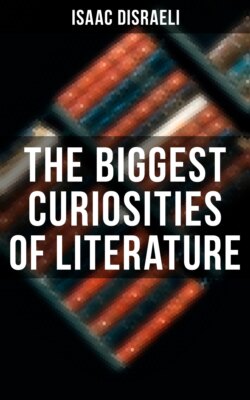Читать книгу The Biggest Curiosities of Literature - Disraeli Isaac - Страница 88
На сайте Литреса книга снята с продажи.
NATURAL PRODUCTIONS RESEMBLING ARTIFICIAL COMPOSITIONS.
ОглавлениеTable of Contents
Some stones are preserved by the curious, for representing distinctly figures traced by nature alone, and without the aid of art.
Pliny mentions an agate, in which appeared, formed by the hand of nature, Apollo amidst the Nine Muses holding a harp. At Venice another may be seen, in which is naturally formed the perfect figure of a man. At Pisa, in the church of St. John, there is a similar natural production, which represents an old hermit in a desert, seated by the side of a stream, and who holds in his hands a small bell, as St. Anthony is commonly painted. In the temple of St. Sophia, at Constantinople, there was formerly on a white marble the image of St. John the Baptist covered with the skin of a camel; with this only imperfection, that nature had given but one leg. At Ravenna, in the church of St. Vital, a cordelier is seen on a dusky stone. They found in Italy a marble, in which a crucifix was so elaborately finished, that there appeared the nails, the drops of blood, and the wounds, as perfectly as the most excellent painter could have performed. At Sneilberg, in Germany, they found in a mine a certain rough metal, on which was seen the figure of a man, who carried a child on his back. In Provence they found in a mine a quantity of natural figures of birds, trees, rats, and serpents; and in some places of the western parts of Tartary, are seen on divers rocks the figures of camels, horses, and sheep. Pancirollus, in his Lost Antiquities, attests, that in a church at Rome, a marble perfectly represented a priest celebrating mass, and raising the host. Paul III. conceiving that art had been used, scraped the marble to discover whether any painting had been employed: but nothing of the kind was discovered. "I have seen," writes a friend, "many of these curiosities. They are always helped out by art. In my father's house was a gray marble chimney-piece, which abounded in portraits, landscapes, &c., the greatest part of which was made by myself." I have myself seen a large collection, many certainly untouched by art. One stone appears like a perfect cameo of a Minerva's head; another shows an old man's head, beautiful as if the hand of Raffaelle had designed it. Both these stones are transparent. Some exhibit portraits.
There is preserved in the British Museum a black stone, on which nature has sketched a resemblance of the portrait of Chaucer.72 Stones of this kind, possessing a sufficient degree of resemblance, are rare; but art appears not to have been used. Even in plants, we find this sort of resemblance. There is a species of the orchis, where Nature has formed a bee, apparently feeding in the breast of the flower, with so much exactness, that it is impossible at a very small distance to distinguish the imposition. Hence the plant derives its name, and is called the Bee-Flower. Langhorne elegantly notices its appearance:—
See on that flow'ret's velvet breast,
How close the busy vagrant lies!
His thin-wrought plume, his downy breast,
The ambrosial gold that swells his thighs.
Perhaps his fragrant load may bind
His limbs;—we'll set the captive free—
I sought the LIVING BEE to find,
And found the PICTURE of a BEE.
The late Mr. Jackson, of Exeter, wrote to me on this subject: "This orchis is common near our sea-coasts; but instead of being exactly like a BEE, it is not like it at all. It has a general resemblance to a fly, and by the help of imagination may be supposed to be a fly pitched upon the flower. The mandrake very frequently has a forked root, which may be fancied to resemble thighs and legs. I have seen it helped out with nails on the toes."
An ingenious botanist, after reading this article, was so kind as to send me specimens of the fly orchis, ophrys muscifera, and of the bee orchis, ophrys apifera. Their resemblance to these insects when in full flower is the most perfect conceivable: they are distinct plants. The poetical eye of Langhorne was equally correct and fanciful; and that too of Jackson, who differed so positively. Many controversies have been carried on, from a want of a little more knowledge; like that of the BEE orchis and the FLY orchis, both parties prove to be right.
Another curious specimen of the playful operations of nature is the mandrake; a plant, indeed, when it is bare of leaves, perfectly resembling that of the human form. The ginseng tree is noticed for the same appearance. This object the same poet has noticed:—
Mark how that rooted mandrake wears
His human feet, his human hands;
Oft, as his shapely form he rears,
Aghast the frighted ploughman stands.
He closes this beautiful fable with the following stanza not inapposite to the curious subject of this article:
Helvetia's rocks, Sabrina's waves,
Still many a shining pebble bear:
Where nature's studious hand engraves
The PERFECT FORM, and leaves it there.
